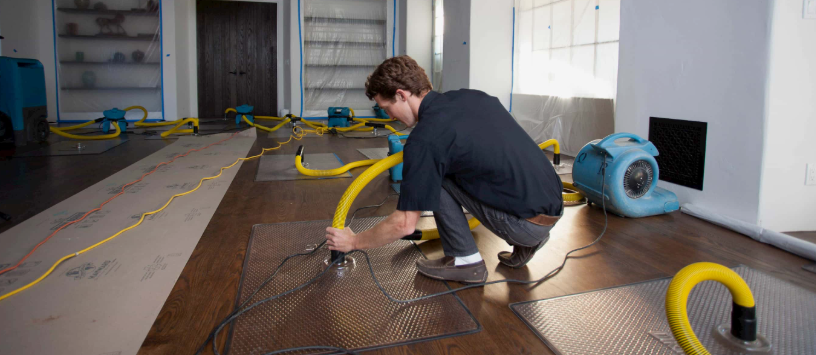Water damage can happen suddenly and cause serious problems for your home or business. Whether it’s due to a burst pipe, a leaking roof, or a natural disaster, knowing what to do in the first 24 hours is crucial. Acting quickly can prevent further damage, save money, and keep you and your family safe. In this guide, we’ll walk you through the essential steps for emergency water damage restoration and highlight how professional services like Flood Express can help.
Step 1: Ensure Safety First
Before you do anything else, make sure your home or business is safe to enter. Water damage can create hazards such as electrical risks, structural issues, and even contamination from sewage or mold. Follow these safety precautions:
- Turn off the power: If it’s safe to do so, switch off electricity and gas to prevent shocks or fires.
- Wear protective gear: Use gloves, boots, and a mask if there’s a risk of contamination.
- Avoid standing water: Floodwater can contain bacteria and other harmful substances.
- Check for structural damage: Look for signs of weakening walls, ceilings, or floors before stepping inside.
Step 2: Identify the Source and Stop the Water Flow
Finding and stopping the source of water is the next crucial step. If the water damage is from a broken pipe, turn off the main water supply immediately. If it’s from a natural disaster or flooding, take steps to minimize additional exposure, such as using sandbags or waterproof barriers. In cases where the source is unclear, professional water damage restoration companies like Flood Express can help locate and fix the issue.
Step 3: Remove Excess Water
The longer water sits, the more damage it can cause. Start removing excess water using the following methods:
- Use a wet/dry vacuum: If you have one, a wet/dry vacuum can quickly remove standing water.
- Mop and towel dry: For small amounts of water, use mops, towels, and buckets.
- Run a sump pump: If you have a sump pump installed, use it to remove large amounts of water.
- Call professionals: If the water damage is extensive, Flood Express has industrial-grade pumps and vacuums to remove water efficiently.
Step 4: Dry Out Affected Areas
After removing standing water, you need to dry the area as quickly as possible to prevent mold and mildew. Here’s how:
- Use fans and dehumidifiers: Place fans around the affected area and run dehumidifiers to remove moisture from the air.
- Open windows and doors: Increase ventilation to speed up drying.
- Remove wet furniture and carpets: Take out soaked items and place them in a dry area.
- Check walls and flooring: If water has seeped into walls or under flooring, professional drying equipment may be needed.
Step 5: Clean and Sanitize
Water damage can bring dirt, bacteria, and even sewage into your home. Thorough cleaning and sanitization are essential to ensure safety.
- Use disinfectants: Clean all affected surfaces with a mild bleach solution or antimicrobial cleaners.
- Dispose of contaminated items: Items like soaked carpeting, upholstery, and insulation may need to be thrown away.
- Clean air ducts and vents: If water has entered your HVAC system, have professionals clean and inspect it.
Step 6: Inspect for Mold and Mildew
Mold can begin to grow within 24 hours of water exposure. Look for signs such as:
- Musty odors
- Dark spots on walls, ceilings, or floors
- Allergy-like symptoms (sneezing, coughing, skin irritation)
If you notice mold, do not attempt to remove it yourself. Mold remediation requires specialized equipment and expertise. Flood Express offers professional mold inspection and removal services to ensure your home is safe.
Step 7: Document the Damage for Insurance
If you have homeowners or renters insurance, documenting the damage is important for filing a claim. Follow these steps:
- Take photos and videos: Capture clear images of all affected areas and belongings.
- List damaged items: Write down all damaged or destroyed property, including estimated values.
- Save receipts: Keep receipts for any repairs, cleaning supplies, or temporary housing expenses.
- Contact your insurance company: File your claim as soon as possible and follow their instructions.
Step 8: Contact a Professional Water Damage Restoration Service
While DIY methods can help in minor cases, severe water damage requires professional assistance. Flood Express offers 24/7 emergency water damage restoration services, including:
- Water extraction and drying
- Mold removal and prevention
- Structural repairs and reconstruction
- Insurance claim assistance
By working with experienced professionals, you can ensure your property is restored quickly and safely.
Preventing Future Water Damage
Once the immediate emergency is handled, take steps to prevent future water damage:
- Regularly inspect pipes and plumbing: Look for leaks or signs of wear.
- Clean gutters and downspouts: Prevent water from pooling around your home.
- Install a sump pump with a backup battery: This can help prevent basement flooding.
- Check for foundation cracks: Seal any cracks to stop water from seeping in.
- Upgrade home drainage systems: Ensure water is properly directed away from your home.
FAQs
1. How long does water damage restoration take?
The time required depends on the extent of the damage. Minor cases may take a few days, while severe damage can take weeks. Professional services like Flood Express can speed up the process with advanced equipment.
2. Can I stay in my home during water damage restoration?
It depends on the severity of the damage. If there is structural damage, mold, or contamination, it may be unsafe to stay. A professional assessment can determine the best course of action.
3. Will insurance cover water damage restoration?
Most homeowners’ insurance policies cover sudden and accidental water damage (like burst pipes) but may not cover flooding or gradual leaks. Contact your insurance provider to understand your coverage.
Conclusion
Emergency water damage restoration is a time-sensitive process. Acting quickly within the first 24 hours can make a huge difference in reducing damage, costs, and health risks. By following these steps and partnering with a professional restoration service like Flood Express, you can restore your home efficiently and prevent long-term issues. If you’re dealing with water damage, don’t wait—take action now!



